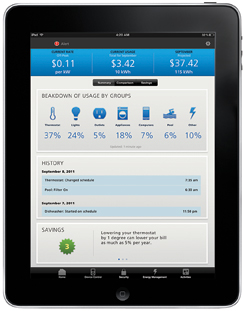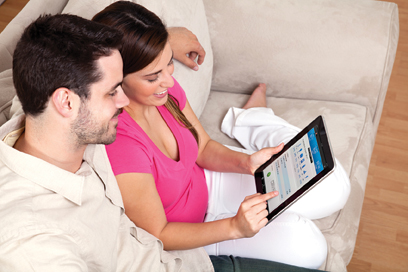For utilities, the electric meter is the gateway to the customer, both figuratively and literally. Beyond supplying a reliable and consistent life-essential commodity, the electric meter can also supply valuable data, which can turn into actionable knowledge that can greatly benefit consumers. And with a wealth of intelligent, connected devices now filling the consumer’s home, the opportunity has never been greater for utilities to help their customers in this new era of the Connected Home.
But there’s a problem: The bulk of smart meters use the ZigBee wireless standard while more and more devices inside the home which control climate, lighting, media, communications and security are largely based on the Z-Wave wireless protocol. That disconnect in standards has left utilities in an unenviable position. They’ve spent considerable time and money to deploy large numbers of smart meters, but those meters can’t connect with the growing number of intelligent devices and appliances inside the house.
Smart Meters – Not All That Smart?
For utilities, getting to the appliance or device level data inside the house can open up significant partnership opportunities with customers to help reduce overall load and smooth out peaks load periods. Studies have shown that customers are eager to get a picture of their total energy use, and how their actions affect it – provided, of course, that the utility safeguards the privacy of their data.
The results of an effective collaboration can be significant. Providing customers with real-time energy use feedback at the appliance level can cut household energy usage by an average of 12% a year, according to a newly-published research review by ACEEE and the University of Colorado. And reducing energy consumption, particularly during periods of heavy use, is far cheaper than building new peaking plants or new transmission lines.
Without access to actual data about how energy is being used inside the house, however, utilities have struggled to find ways to provide customers with useful information. A new generation of interval meters collects data at hourly intervals, or even in some cases on 15-minute increments, providing a much more fine-grained picture of energy use than was available in the past.
Some utilities are trying to harness those data streams by teaming up with cloud-based centers that collect that data, aggregate it, and provide it to customers in a way that they can use. Typically, these programs can tell customers how much electricity they used in the current week or the latest billing period, and allow them to compare that with previous periods. Utilities are offering comparisons not only with a customer’s own usage, but with that of other customers, allowing homeowners to compare their energy use with that of their neighbors.
The Real Prize: Appliance and Device Level Data
This more frequent interval data has also allowed utilities to experiment with time-of-day pricing, providing an incentive for customers to shift their usage out of certain hours of the day. All this data, however, is “whole house” data, and utilities are finding that these programs typically deliver only a few percentage points of reduction in energy use. For many utilities the jury is still out on whether they are cost effective or not.
For customers to really shift their usage, they need better information than whole house data. Without access to data showing the actual energy consumption of various appliances or devices inside the house, and with sub-metering individual appliances generally cost-prohibitive, some utilities are taking the approach of modeling – essentially guessing – what’s going on inside the customer’s house.
The modeling is generally based on assumptions from very fine interval data, sometimes down the to the second. A surge in power consumption in the middle of a hot summer afternoon, for example, can be assumed to be the air-conditioning unit powering up. These time-series simulations can provide a reasonable model of usage data, but it’s still just an estimate. Customers tend to find this approach less than satisfactory, and want specific information that can be sorted by various criteria including (but not limited to) time of day, type of device(s), room by room, or even usage by individual family members.
The Ascent of the Connected Home
The result has been a level of frustration with smart meters. Utilities have aggressively deployed the new meters, spending tens or hundreds of millions of dollars in the process, and found they’ve gotten little in return for their investment.
The data that utilities need in order to get real value from these deployments, however, is available only a few feet away from all these smart meters utilities have worked so hard to roll out. Inside the home, the Z-Wave standard – a low-bandwidth wireless technology, which allows devices to communicate with each other – has been quickly gaining ground. To date, over 500 consumer items, from door locks to outlets to light switches to security components to thermostats, have been certified as compatible and compliant.
These devices can respond to the directives or even passive actions from a home’s occupants, or from other devices, making the long-awaited Connected Home a reality. A single tap on a remote next to your bed can turn off all the lights in your house after you’re under the covers, as well as lower the thermostat and make sure the back door is locked. When your children arrive home from school and type their access code into a compatible door lock, the thermostat can raise the temperature, the lights will come on in the kitchen and the playroom, and a text will be delivered to your cell phone.
After years of struggling to reap the benefits of smart meters, utilities can now integrate their whole house data into the overall Connected Home eco-system. And customers who choose to grant their utility access to their appliance level data can gain useful insights into their home’s energy usage, regardless of the type of electric meter they have.
The result is a wealth of data that utilities can use to provide sophisticated home energy use applications to customers.
To date, most of the smart meters deployed by utilities have been based on the ZigBee standard, which have not been able to communicate with Z-Wave devices inside the home. However, a new generation of “bridge devices” enables virtually any electric utility meter - old or new - to communicate with any Z-Wave compatible device. Using Electric Power Research Institute (EPRI) and Universal Smart Network Access Port (USNAP) standards, these bridge devices enable ZigBee-based meters to wirelessly exchange data with Z-Wave devices, and can also be extended to communicate with other protocols as well, allowing them to communicate with a wide range of current and future wireless standards. Even older electro-mechanical meters can now be connected using bridge technology.
Next generation bridge devices can significantly enhance the value of utilities’ residential demand response programs because studies have shown that customers are far more likely to change their usage behaviors if the utility can provide them with detailed data about their usage and related costs.
The Connected Home
Utilities which can access the appliance-level data found inside the home will not only have more satisfied customers, but access to a new world of business opportunities.
That’s because the unprecedented level of intelligence now found inside our homes’ devices is transforming our formerly brick and mortar houses into Connected Homes. Among the trends at play in this transformation are:
- Consumers who are more and more comfortable with technology; who are used to using products such as Apple iPhones and iPads to control and enhance their lifestyles via user-friendly and intuitive interfaces; and expect to always be connected - both in and out of the home.
- An emerging regulatory environment from both federal and state governments, where utilities (and even entire countries) are required to have better control over the generation, distribution and consumption of power in homes.
- Powerful commercial players such as broadband providers, seizing opportunities to increase their average revenue per user (ARPU), reduce churn and become solutions providers rather than just “dumb-pipes.” Broadband carriers AT&T, Comcast and Verizon have already unveiled product offerings for the Connected home.
- Technological convergence with increasing focus on standardization and interoperability of wireless standards (i.e. Z-Wave, ZigBee, 802.11 Wi-Fi, etc.) while at the same time, the cost of electronic components and chipsets are trending down.

The Connected Home’s Central Nervous System
The concept of the Connected Home can seem daunting. It may be useful to think of analogy we’re all familiar with: the human body.
The human body is made up of the digestive, respiratory, circulatory and other systems, and each of these sub-systems is made up of a series of organs. The digestive system, for example, includes the stomach, small intestine and large intestine, which can be thought of as “components.”
The human body also has a series of “input sensors” – our eyes, ears, nose, tongue and skin, which are tied together with the body’s other components and sub-systems through a central nervous system, which serves as the “network” for our body, carrying critical, real-time information to the human brain - our “central processor.”
All these systems work together to enable us to speak, think, walk and perform the myriad other things we accomplish every day. You can think of these capabilities as “applications” of the human body that enable us to live our daily lives, without very much attention to “how” our bodies accomplish these amazing things, day in, day out.

Like the human body, our homes are made up of a variety of sub-systems, including the electric supply, plumbing, HVAC, telephones, lighting, computers and security. Each of these sub-systems is made up of individual components and input/output sensors in the home include thermostats, motion detectors, open/closed door and window sensors, humidity sensors, rain gauges, electric utility meters, etc.
Until the past few years, there has been no consistent “central nervous system” for the home, and consumers have had to live with a myriad of network protocols: our home’s electrical wiring; copper wiring for POTS (plain old telephone system), Ethernet or Wi-Fi for data communication, infrared for remote controls and a variety of proprietary approaches. The rapid expansion of the Web over the past ten years has shown that most enterprises have more to gain than lose by complying with industry-wide networking standards.
Fortunately, for homeowners, the standards of the Connected Home are becoming more and more clear, and bridge technology is now in place to fill any remaining gaps. As such, utilities can now take their rightful place inside the Connected Home to add value to both consumers and their own stakeholders.
About the Author
 Mike Harris is Chief Executive Officer of Zonoff, Inc. As a successful serial entrepreneur, he has founded and/ or led numerous venture-backed technology companies to successful exits, including a NASDAQ IPO. Harris is a graduate of Purdue University with a degree in Computer and Electrical Engineering.
Mike Harris is Chief Executive Officer of Zonoff, Inc. As a successful serial entrepreneur, he has founded and/ or led numerous venture-backed technology companies to successful exits, including a NASDAQ IPO. Harris is a graduate of Purdue University with a degree in Computer and Electrical Engineering.







